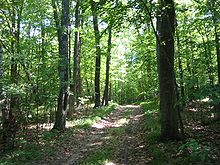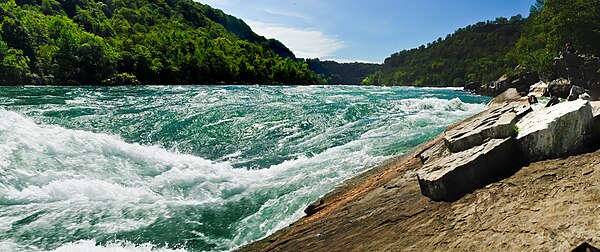Forests of Canada

The forests of Canada are located across much of the country. Approximately half of Canada is covered by forest, totaling around 2.4 million km2 (0.93 million sq mi).[1] Over 90% of Canada's forests are owned by the public (Crown land and Provincial forest). About half of the forests are allocated for logging.
Named forests are found within eight distinct regions. These forests may also be part of ecosystems, a number of which extend south into the United States. For example, the Northern hardwood forest is an ecosystem located in large areas of southeastern and south central Canada as well as in Ontario and Quebec. This system extends south to west and even into the United States.
Ontario alone makes up for 20% of Canada's Forests, which equates to roughly 2% of the forests in the world.[2] Ontario follows strict laws and regulations to manage its forests in a sustainable way. Ontario Forests are mainly managed by the Ministry of Northern Development, Mines, Natural Resources and Forestry (NDMNRF).[3] They ensure a fair trade between sustaining the forest, while protecting the biodiversity of the ecosystem and providing legal methods for harvesting to benefit the economy.[2]
Statistics
[edit]Canada possesses 367 million hectares (ha) of forest, which constitutes 9% of the global forest area and 25% of the worldwide boreal forest. As of 2022, 72% of the Crown forest land under management in Canada is certified according to third-party sustainable forest management standards. Approximately 10% of Canada’s forests are designated as protected areas (2022).[4]
The forest sector in Canada contributed $33. 4 billion (1. 2%) to the nation’s nominal GDP in 2022. In the same year, this sector employed 212,660 individuals, with average annual earnings estimated at $51,900 (2022).[4]
Protection
[edit]The protection of Canada’s forests is reinforced through robust legislation and regulations at the federal, provincial/territorial, and municipal levels. Sustainable forest management (SFM) represents a collaborative initiative involving all tiers of government, industry stakeholders, and the general public. Numerous key federal statutes underpin the objectives of SFM, including the:[4]
- Forestry Act
- Species at Risk Act
- Migratory Birds Convention Act
- Fisheries Act
- Impact Assessment Act
- Canadian Environmental Protection Act
- Pest Control Products Act
- Fertilizers Act
The Species at Risk Act plays a critical role in Canada’s strategy to safeguard biodiversity, having been established to fulfill Canada’s obligations under the United Nations Convention on the Conservation of Biodiversity.
Regions
[edit]
The forests of Canada are located within eight regions:[5][6]
- Acadian Forest Region - This region comprises a temperate broadleaf and mixed forest ecoregion located in Quebec as well as the Maritime Provinces in Eastern Canada, and extends into the United States.[7]
- Boreal Forest Region - This the largest forest region in Canada. It is located in the north and contains about one third of the world's circumpolar boreal forests.
- Coast Forest Region - Located on the west coast, this region almost entirely comprises coniferous trees including the Douglas-fir, Sitka spruce, western hemlock, and western red cedar.
- Columbia Forest Region - Also mostly comprising coniferous trees, this region is located between the Rocky Mountains and the central plateau in British Columbia.
- Deciduous Forest Region - This region is located between Lake Huron, Lake Ontario, and Lake Erie in southwestern Ontario.[8]
- Great Lakes-St. Lawrence Forest - This region is the second largest (the boreal being the largest), and is located from southeastern Manitoba to the Gaspé Peninsula.[8]
- Montane Forest Region - Located in the west of Canada, this region covers parts of the Kootenays, the central plateau of British Columbia, and a number of valleys close to Alberta's border.[8]
- Subalpine Forest Region - This region is located in British Columbia and Alberta. It covers the Rocky Mountains from the west coast to Alberta's uplands.[8]
By Province
[edit]The following is a list of forests, ecoregions, ecozones, forested parklands and provincial parks.
Alberta
[edit]
- Alberta Mountain forests
- Alberta-British Columbia foothills forests
- Aspen parkland
- Mid-Continental Canadian forests
- Muskwa-Slave Lake forests
- North Central Rockies forest
British Columbia
[edit]
- Alberta-British Columbia foothills forests
- Aspen parkland
- British Columbia mainland coastal forests
- Cascade Mountains leeward forests
- Elkington Forest
- Fraser Plateau and Basin complex
- Great Bear Rainforest
- Inland rainforest
- Lower Mainland Ecoregion
- Malcolm Knapp Research Forest
- Muskwa-Slave Lake forests
- North Central Rockies forest
- Northern Pacific coastal forests
- Pacific temperate rainforests
Manitoba
[edit]- Agassiz Provincial Forest
- Belair Provincial Forest
- Brightstone Sand Hill Provincial Forest
- Cat Hills Provincial Forest
- Cormorant Provincial Forest
- Duck Mountain Provincial Forest
- Mid-Continental Canadian forests

- Midwestern Canadian Shield forests
- Moose Creek Provincial Forest
- Northwest Angle Provincial Forest
- Porcupine Provincial Forest
- Provincial forests
- Sandilands Provincial Forest
- Spruce Woods Provincial Forest
- Swan-Pelican Provincial Forest
- Tallgrass Aspen Parkland
- Turtle Mountain Provincial Forest
- Wampum Provincial Forest
- Whiteshell Provincial Forest
Newfoundland
[edit]Nova Scotia
[edit]Ontario
[edit]
- Barker's Bush
- Carolinian forest
- Central Canadian Shield forests
- Crothers Woods
- Eastern Great Lakes lowland forests
- Ganaraska Region
- Haliburton Forest
- Happy Valley Forest
- John E. Pearce Provincial Park
- Larose Forest
- Laurentian Mixed Forest Province
- Long Point, Ontario
- Midwestern Canadian Shield forests
- Mixed Wood Plains Ecozone (CEC)
- Niagara Glen Nature Reserve
- Obabika Old-Growth Forest
- Pinery Provincial Park
- Point Pelee National Park
- Rock Glen Conservation Area
- Rock Point Provincial Park
- Rondeau Provincial Park
- Short Hills Provincial Park
- Southwest Elgin Forest Complex
- Western Great Lakes forests
- Wheatley Provincial Park
Prince Edward Island
[edit]Quebec
[edit]
- Angell Woods
- Bois Beckett Forest
- Central Canadian Shield forests
- Eastern Canadian forests
- Eastern Canadian Shield taiga
- Eastern Great Lakes lowland forests
- Great North Woods
- Laurentian Mixed Forest Province
- Mixed Wood Plains Ecozone (CEC)
Saskatchewan
[edit]
- Canwood Provincial Forest
- Fort à la Corne Provincial Forest
- Nisbet Provincial Forest
- Northern Provincial Forest
- Porcupine Provincial Forest
- Torch River Provincial Forest
Yukon
[edit]Other forest areas
[edit]
Temperate broadleaf and mixed forests
[edit]- Beech-maple forest - This forest is located mostly in eastern United States and extends into southern Canada.[10]
- Carolinian forest
- Eastern forest-boreal transition
- Eastern Great Lakes lowland forests
- John E. Pearce Provincial Park
- Long Point, Ontario
- Niagara Glen Nature Reserve
- Northern hardwood forest
- Pinery Provincial Park
- Point Pelee National Park
- Rock Point Provincial Park
- Rondeau Provincial Park
- Short Hills Provincial Park
- Southwest Elgin Forest Complex
- Western Great Lakes forests
- Wheatley Provincial Park
See also
[edit]References
[edit]- ^ "Total forest coverage by country". the Guardian. 2 September 2009. Retrieved 23 September 2018.
- ^ a b "State of Ontario's Natural Resources - Forest 2021".
- ^ "Ministry of Northern Development, Mines, Natural Resources and Forestry".
- ^ a b c "THE STATE OF CANADA'S FORESTS - Annual Report 2023" (PDF). library and archives Canada Canadian Forest Service. Retrieved 2025-01-15.
{{cite web}}: line feed character in|title=at position 13 (help) - ^ "Forest classification". Natural Resources Canada. 14 June 2017. Retrieved 24 September 2018.
- ^ "Forest Regions - The Canadian Encyclopedia". www.thecanadianencyclopedia.ca.
- ^ "New England/Acadian Forests". www.cas.vanderbilt.edu.
- ^ a b c d "Canada's Forests - Sustainability and Management - CCFM". www.sfmcanada.org. Archived from the original on 2021-03-01. Retrieved 2018-09-23.
- ^ "Natural Areas". 11 January 2018.
- ^ "Eco Succession". Archived from the original on 2008-12-26. Retrieved 2018-09-23.
External links
[edit] Media related to Forests in Canada at Wikimedia Commons
Media related to Forests in Canada at Wikimedia Commons

